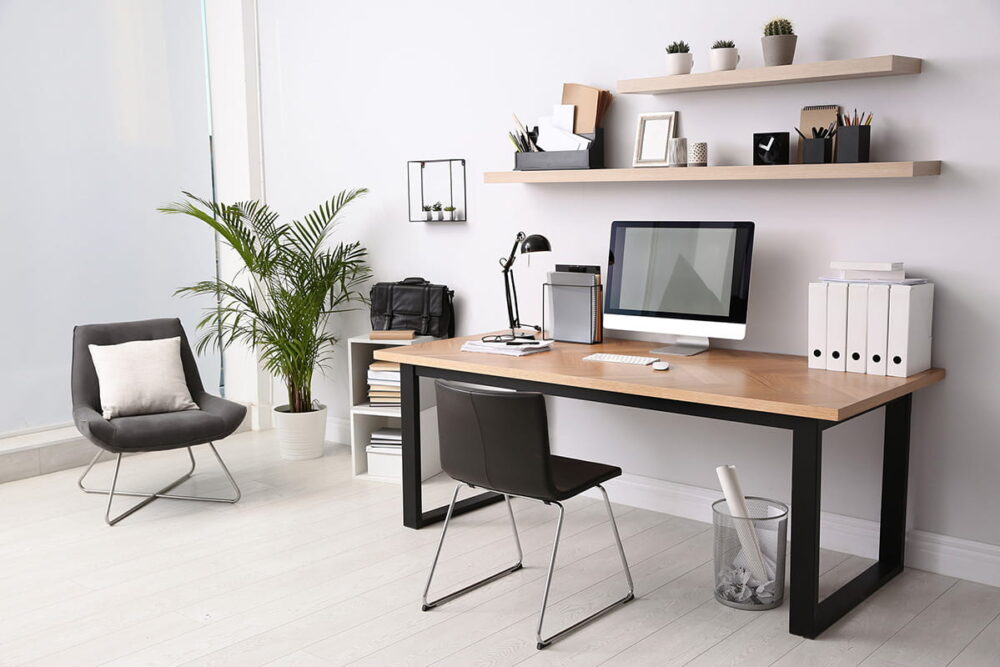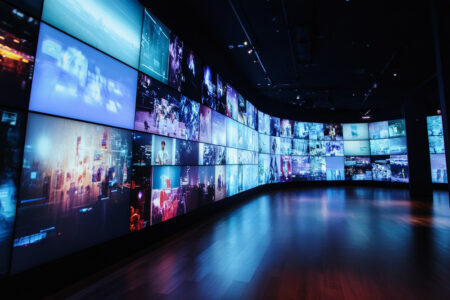May 14, 2020
Spiffing Up That Corner Home Office

Like much of the world, we’re working from a home office now, due to the COVID-19 outbreak. Aside from it being much quieter (we only have two cats for company here, and they’re not particularly noisy), we’re making do with a vintage-2017 laptop, reasonably fast broadband, and the vagaries of online tele/videoconferencing programs like Zoom, Skype, GoToMeeting, and WebEx.
For those readers fortunate to have a dedicated space for a home office, the minimum setup is generally a laptop computer with a built-in camera and microphone. (And yes, we know there are folks who still use desktop computers with separate cameras and mics.) It’s a pretty pedestrian arrangement and one that could use some enhancements here and there. While convenient, the audio and video quality from laptops varies widely and is also impacted by the quality of the broadband connection and the codecs used by the streaming service.

Laptops, by design, don’t have very large speakers built into them. That in turn affects audio quality, which might motivate one to invest in a pair of amplified speakers. Based on observation, these are particularly helpful when participating in online Pilates and yoga classes where the viewer is sitting (by necessity) some distance away from the screen, and by extension, the speakers. We’ve also found these to be very helpful when a family member is engaged in an online art class.
On-board microphones can also use some help. In general, a directional microphone connected to a USB interface is going to sound a lot cleaner during a Zoom session simply because the mic is directional and not prone to picking up background noise from the washing machine, screaming children, or barking dogs. Also, internal microphones often employ some sort of automatic gain control to compensate for their lack of directivity, another enhancement you won’t need with an outboard directional mic.
How about that small screen? Our office happens to have a 46-inch LCD TV in it, across from the desk. For a group meeting, the overall experience can be enhanced by connecting it to the laptop and using it as the primary monitor, along with a separate microphone. You can see those tiny faces in tiny windows more clearly, and your audio will sound a lot better to them. Add an external USB camera, and you can close the lid of your laptop altogether. (That large display screen is also quite beneficial for online yoga, Pilates, and art instruction we mentioned earlier!)
For those folks who rely on tablets and (horrors!) smartphones to participate in Zoom or Skype meetings, it gets old in a hurry. It best to find a larger screen of some sort, like that new Ultra HDTV you picked up for the Super Bowl, and “cast” your tablet/smartphone screen to it. Put on a headset or a pair of earbuds with a microphone for better audio (higher signal-to-noise ratio) and to cut down on ambient room noise in your ears (like that washing machine or the barking dog).
Web conferencing services offer an option to record the meeting. But there’s no reason why you couldn’t just do it yourself locally: All you need is a connection to the HDMI or DisplayPort output of your computer, and an SD-card recording system. If you don’t need the video (and that’s usually the case), use an HDMI de-embedder and simply record to one of many SD-card-based portable audio recorders. They work very well and won’t break the back. We keep one here for recording everything from local bands to worship services.
One complaint we have about modern laptops is that they’re stingy with USB connections. By the time we’ve connected an external camera, external microphone, printer, and some sort of external recorder, we’re long out of ports. So, a USB extender or multi-port USB distribution system is a handy part of the home toolbox. Make sure you have the right USB plug type, as newer laptops are all moving to Type-C connectors. (And some of those also double as external display connectors, using Alternate Mode.)
AND WHILE WE’RE ON THE SUBJECT…
There’s an old saying – “The problem isn’t the car; it’s the nut behind the wheel.” We’ve participated in several teleconferences during the pandemic using a variety of software platforms, and we’ve seen both the best and the worst of conferencing practices. Admittedly, this is a new and unfamiliar way for many people to communicate – some are surprised that their laptop cameras and microphones even work correctly!
Talking about cameras…the angle of your laptop screen is kinda important. Tilt it too far back, and other conference participants will see a nice view of your ceiling and maybe a tiny bit of your head. Make sure the screen is tilted forward enough so that you wind up with a nice head-and-shoulder composition. The resulting screen angle might not be the one you normally use, but everyone else will be able to see more of you. (You can also elevate your laptop to compensate.)
Of course, an external USB camera eliminates this problem. We’ve found several models online at affordable prices. Some have tilting bases and sit on a desktop, while others can sit atop computer monitors and are also tilting types. All models have built-in microphones.
Where you position your mobile device, laptop, or external camera also matters. As a rule of thumb, don’t sit with windows or other bright light sources behind you – the camera will “iris down” to compensate for the exposure, and you’ll come across as rather shadowy! Try to position your camera so your back is to a neutral, uncluttered background and let as much light fall in your direction. (Bookshelves seem to be popular backdrops these days, especially with authors.)

Where you position your mobile device, laptop, or external camera also matters. As a rule of thumb, don’t sit with windows or other bright light sources behind you – the camera will “iris down” to compensate for the exposure, and you’ll come across as rather shadowy! Try to position your camera so your back is to a neutral, uncluttered background and let as much light fall in your direction. (Bookshelves seem to be popular backdrops these days, especially with authors.)
Some conferencing programs let you create a virtual backdrop, but don’t go crazy with it – no one wants to see pictures of your pets, your boat/sportscar, or your collection of beer cans. Take your phone outside and shoot a picture of a nice, bucolic forest, or field of garden and try that. Or pictures of the ocean, or even just the sky. Nothing busy or distracting! You may also have the option of blurring the background, creating an effect known as bokeh.
You can also set up a table or floor lamp (or even a work light) with soft white LED bulbs to boost light levels. The more light your Webcam has to work with, the sharper and cleaner your video will be, even after it is compressed to death. If you have white or off-white ceilings in your room, try bouncing light instead of direct light – you’ll wind up with softer, more diffuse shadows.
If possible, try a USB headset instead of the built-in mic on your device. Headsets block out distracting audio from outside the room and eliminate any possibility of feedback loop echoes from a local speaker and laptop/tablet/phone microphone, unfortunately, a regular occurrence in conferences where participants are using their smartphone as a speakerphone. (Those echoes are REALLY annoying to everyone else!) Plus, other people in your house won’t have to listen to the conference.
And when you’re not going to be talking for a while, mute your microphone so that no one has to hear the garbage truck outside, or your dog barking at a mail carrier. If something comes up that will distract you from the meeting, turn off your camera as well – no need for others to see you scurrying to pick up a wayward child and move them to another room.
We didn’t think we needed to remind anyone to dress appropriately, but apparently, some conferencing attendees have taken “business casual” to a new level. And yes, we’ve heard plenty of stories about folks who are dressed from the waist up, but are only wearing pyjamas, and underwear, or going commando from the waist down. (If the camera can’t see it, it’s safe, right?)
Look – It’s a meeting, after all, so show a modicum of respect for other participants. You don’t have to put on formal business wear, but at least avoid the logo T-shirts and tank tops, and pick out a nice collared shirt, blouse, or polo shirt. Surprise everyone, and throw on a blazer. Stick to colors with neutral gray values – no blinding white or deep black colors, which will again throw off the camera. And a little grooming goes a long way. You may not be in the office, but you are in an office of sorts. (What you wear on your feet, however, is up to you…)
Would you like to consult with Kramer?








